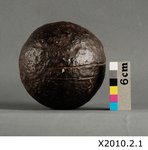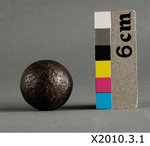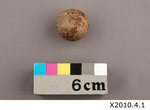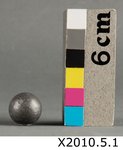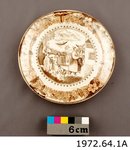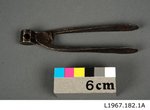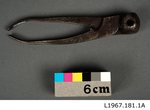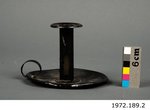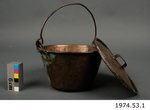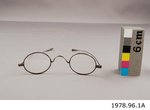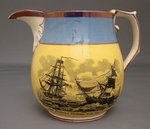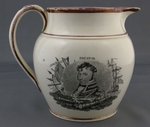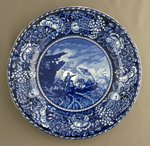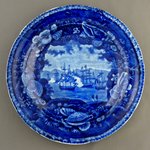Résultats
- The medal was issued to Sergeant Angus Cooke in 1815. The medal was donated by Mrs. Ruth Margaret (Scott) Hilman in 1982.The medal was issued to Sergeant Angus Cooke in 1815. The medal …
- This medal was issued to Sergeant Angus Cooke in 1848. The medal was donated by Mrs. Ruth Margaret (Scott) Hilman in 1982.This medal was issued to Sergeant Angus Cooke in 1848. The medal …
- This medal was issued to Sergeant Angus Cooke in the 1830s. The medal was donated by Mrs. Ruth Margaret (Scott) Hilman in 1982.This medal was issued to Sergeant Angus Cooke in the 1830s. The …
- This type of cannon ball was used during the War of 1812. This round, black ball of iron has a pitted surface and is 14 1/2 inches in circumference and 5 inches in diameter. There is a 4 mm wide andThis type of cannon ball was used during the War of 1812. …
- This type of ammunition, known as a grapeshot, was used in artillery during the War of 1812. A round black ball of iron with a pitted surface, this grapeshot has a circumference of 4 1/8 inches. GrapThis type of ammunition, known as a grapeshot, was used in artillery …
- This is an example of ammunition used in artillery during the War of 1812. Commonly termed a grapeshot, this round grayish ball of lead has a circumference of 3 3/4 inches. The surface is not smoothThis is an example of ammunition used in artillery during the War …
- This type ammunition was used in a musket during the War of 1812. A small round silver ball of lead, this musket ball is 2 1/8 inches in circumference. The surface is shiny and smooth with a visibleThis type ammunition was used in a musket during the War of …
- The plate was donated from Cla-Saun Antiques on Queenston Street, St. Catharines. At the time of the donation the plate was recorded as a Spode plate circa 1790-1820.The plate was donated from Cla-Saun Antiques on Queenston Street, St. Catharines. …
- A musketball mould of the type made and used pre-1830. An iron, plier-like tool with two handles. At the end of each handle is a mini-pan with semi-spherical moulds inside. When the two handles are bA musketball mould of the type made and used pre-1830. An iron, …
- This type of musketball mould was made pre-1830 or earlier and would have been used during that time. An iron, plier-like tool with two handles. At the end of each handle is a semi-spherical mould. WThis type of musketball mould was made pre-1830 or earlier and would …
- A leather bucket used to put out fires. This type bucket was used in the 1820's and may have been from the St.Catharines area. The black, leather bucket is approximately 12 inches in height, 9 inchesA leather bucket used to put out fires. This type bucket was …
- This circa 1825 lantern is rather rare. It is a black, cylindrical tin lantern with a conical top. There is a moveable handle on the top with a circular loop. There is also a tin handle on the side.This circa 1825 lantern is rather rare. It is a black, cylindrical …
- A candleholder used during the 18th and 19th centuries. Black, metal (tin) candleholder, approximately 4 5/8 inches tall. The bottom is a round shallow dish approximately 5 3/4 inches x 5 3/4 inches.A candleholder used during the 18th and 19th centuries. Black, metal (tin) …
- From the estate of George Macnoe, who died in October 1973. The kettle was previously owned by a relative who died in New York in the early 19th cenutry around the time of the War of 1812.From the estate of George Macnoe, who died in October 1973. The …
- Donated by Robert Leggate, the eyeglasses belonged to his grandmother ca. 1830s.Donated by Robert Leggate, the eyeglasses belonged to his grandmother ca. 1830s.
- A yellow, blue and copper milk or cream jug with naval battle scenery on either side.A yellow, blue and copper milk or cream jug with naval battle …
- Major General Zac Brown was in charge of the crew of the Niagara during the Battle of Lake Erie. Stephen Decatur Jr. was also an American Naval Hero from the War of 1812. During the War he was assignMajor General Zac Brown was in charge of the crew of the …
- Transferware Teapot Blue and White portraying a scene from the War of 1812 in which commodore MacDonough is victorious.His most notable achievement occurred during the War of 1812. As commander of AmTransferware Teapot Blue and White portraying a scene from the War of …
- On the back of the plate it says: Commodore Perry Leaving the Lawrence, Sept 10th 1815 "We Have met the Enemy and they are ours." Staffordshire England (Makers Mark)On the back of the plate it says: Commodore Perry Leaving the …









